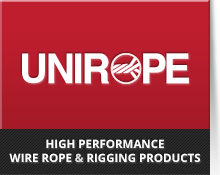Web Sling Mechanical Considerations
- Web slings in contact with edges, corners, protrusions or abrasive surfaces SHALL ALWAYS be protected with materials of sufficient strength and construction to prevent sling damage.
- Web slings should be protected from abrasive surfaces.
- Determine the weight of the load. Web slings shall not be loaded in excess of the rated capacity. Consideration shall be given to the sling angle, which affects rated capacity.
- Select web slings having suitable characteristics for the type of load, hitch and environment.
- Web slings that are used in a choker hitch shall be of sufficient length to ensure that the choke point should always be on the sling body—not on the sling eye, fitting, base of the eye or fitting, load bearing splice or tag.
- Web slings used in a basket hitch shall have the load balanced to prevent slippage and maintain control of the load.
- The openings in fittings shall be the proper shape and size to ensure that the fittings will seat properly on the web sling, crane hook or other attachments.
- Web slings should not be dragged on the floor or over an abrasive surface.
- Web slings shall not be twisted, shortened, lengthened, tied into knots or joined by knotting. Web slings shall be shortened, lengthened or adjusted only by methods approved by the manufacturer.
- Web slings should not be pulled from under loads when the load is resting on the web sling. Loads resting on web slings could damage the sling.
- Web slings shall not be used for pulling against stuck, snagged or restrained objects if loading conditions are unknown.
- If a sling is used for non-lifting applications under known loading circumstances and within the rated sling capacity, it may be returned to lifting service.
- Marking Slings for Dedicated Applications – Slings that are used for pulling against stuck, snagged or restrained objects in loading conditions that are unknown shall not be used for ANY lifting application. These Dedicated Application slings shall be marked “Not For Lifting”.
- Do not drop web slings equipped with metal fittings.
- Web slings that appear to be damaged shall not be used unless inspected and accepted as usable by a qualified person.
- Web slings shall be hitched in a manner providing control of the load.
- Personnel shall not stand under, on or next to suspended loads or rigging that is under tension.
- All portions of the human body shall be kept from being placed between the web sling and the load and from between the web sling and handling or lifting device.
- Personnel shall not ride web slings or loads suspended by web slings. Web slings shall not be used as bridles on suspended personnel platforms.
- Shock loading shall be avoided.
- Load applied to a hook shall be centered in the bowl of the hook to prevent point loading.
- During use, personnel shall be alert for possible snagging.
- The web sling legs (branches) shall contain or support the load from the sides above the center of gravity when using a basket hitch.
- Tags and labels should be kept away from the load, hook and point of choke.
- Web slings should not be constricted or bunched between the ears of a clevis, shackle or in a hook. When a web sling is used with a shackle, it is recommended that it be used (rigged) in the bow of the shackle. When this is not possible, protect the sling eyes or connection points from damage.
- Place blocks under load prior to setting down the load to allow removal of the web sling, if applicable.
- For multiple-leg slings used with nonsymmetrical loads, an analysis by a qualified person should be performed to prevent overloading of any leg.
- Do not machine- or power spray wash and do not dryclean web slings as a loss of strength is possible due to mechanical/chemical damage. If web slings have to be cleaned use mild soaps and soft brushes which do not damage the sling fibres.



